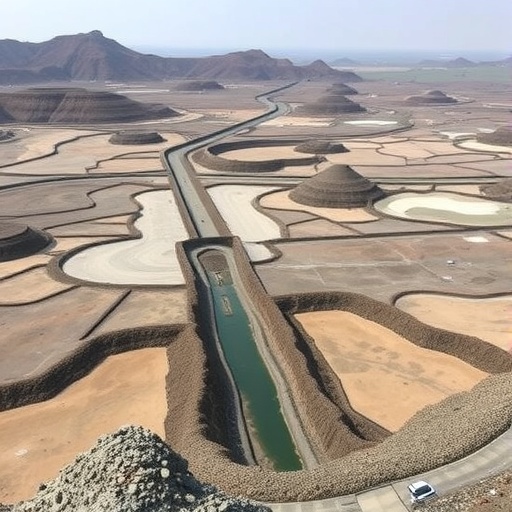In a groundbreaking study published in Environmental Earth Sciences, researchers from China have unveiled a comprehensive analysis concerning the manganese background values in the shallow groundwater of the Jidong Plain. This meticulously conducted investigation not only quantifies the natural baseline concentration of manganese but also probes deeply into the geochemical and environmental factors that contribute to elevated manganese levels in this vital groundwater resource. Given the implications for public health, agriculture, and water management, this study offers a crucial scientific foundation for future interventions and policies in the region and beyond.
Manganese, a naturally occurring element, assumes a dual role in both environmental contexts and human health. While essential as a trace nutrient, excessive concentrations in drinking water have been associated with neurological disorders and various toxic effects. The Jidong Plain, an expansive and densely populated region with substantial agricultural and industrial activities, has drawn attention due to sporadically high manganese contents detected in shallow groundwater. Until now, the absence of a detailed, region-specific baseline or “background” value has presented challenges in distinguishing anthropogenic pollution from natural geochemical variation.
The researchers employed a strategic sampling framework, gathering a broad dataset of groundwater samples across the Jidong Plain. Utilizing high-precision analytical techniques, including inductively coupled plasma mass spectrometry (ICP-MS), the team quantified manganese concentrations with exceptional accuracy. Their findings revealed a spatially heterogeneous distribution of manganese, with localized regions exhibiting concentrations markedly above global average background values. This heterogeneity underscores the complex interplay between geological substrates, hydrological processes, and human impact.
Integral to their study was the identification of contributing mechanisms behind the high manganese background levels. The team examined geological formations—particularly the mineralogy of aquifer sediments rich in manganese-bearing minerals such as pyrolusite and braunite—which serve as primary natural sources. Additionally, the redox conditions within the aquifers, influenced by organic matter availability and microbial activity, were found to greatly affect manganese mobilization. Under reducing conditions, manganese oxides can be dissolved, releasing manganese ions into groundwater, thereby elevating the manganese background value.
The study’s novelty lies also in its multifaceted approach: by integrating hydrogeochemical modeling with field observations, the researchers elucidated the dynamic balance between natural geochemical processes and potential anthropogenic influences such as agricultural runoff, industrial discharge, and land reclamation activities. Although the Jidong Plain has undergone significant land use changes in recent decades, the predominant factor for elevated manganese appears to be natural geogenic enrichment amplified by localized redox dynamics rather than widespread contamination.
Beyond merely establishing background manganese levels, the study offers a framework for differentiating natural background from pollution-driven anomalies. This distinction is paramount for regulatory bodies tasked with interpreting water quality data and implementing mitigation strategies. The authors advocate for adopting background values tailored to local hydrogeological settings, rather than relying on generalized or international standards that may misrepresent the actual natural baseline.
The implications for public health are profound, especially considering the widespread use of shallow groundwater for drinking and irrigation in the Jidong Plain. Long-term exposure to manganese concentrations exceeding recommended thresholds can lead to neurotoxic effects, particularly in vulnerable populations such as children and pregnant women. Hence, the authors stress the necessity of comprehensive groundwater monitoring programs that incorporate the new baseline data to accurately assess risks and prioritize hotspots.
Furthermore, the research delves into potential mitigation and management strategies informed by their findings. For instance, enhancing oxygenation of groundwater through artificial recharge or land management could reduce manganese solubilization. In agricultural contexts, modifying fertilizer application and organic waste management could indirectly influence aquifer redox states and manganese levels. Such targeted interventions, grounded in robust scientific understanding, highlight the translational value of the study.
This investigation also contributes to the wider discourse on trace metal dynamics in groundwater systems under changing environmental conditions, including climate variability and intensified human activity. The methodologies and insights presented are transferable to other regions experiencing similar challenges, providing a blueprint for assessing and managing trace metal backgrounds in diverse aquifer systems.
One of the more intriguing revelations involves the interplay between manganese and other co-occurring elements such as iron and arsenic within the aquifers. The redox-sensitive nature of these metals implies that shifts in groundwater chemistry may simultaneously mobilize multiple contaminants, complicating water treatment and risk assessment efforts. This interdependence accentuates the need for integrated monitoring programs that go beyond single-element analyses.
The study also highlights how advancements in geospatial analysis and remote sensing can augment traditional hydrogeochemical sampling, enabling more comprehensive mapping of manganese distribution and its controlling factors at fine scales. Implementation of such technologies promises to enhance early detection of problematic zones and inform proactive groundwater management.
Importantly, the authors acknowledge limitations, including the temporal variability inherent to groundwater systems and the need for long-term studies to capture seasonal and anthropogenic fluctuations comprehensively. They call for continued interdisciplinary research, connecting hydrogeologists, environmental chemists, microbiologists, and public health experts to fully unravel the complexity of manganese behavior in groundwater.
In conclusion, this seminal work by Wang, Yuan, and colleagues marks a significant stride in understanding manganese background values in the Jidong Plain’s shallow groundwater, providing both fundamental knowledge and practical tools to address groundwater quality challenges. It sets a precedent for defining region-specific contaminant baselines and underscores the significance of integrating natural geological factors when assessing environmental risks and formulating management policies. As groundwater resources become increasingly vital amidst global water scarcity, studies like this illuminate paths towards sustainable and safe water use.
Subject of Research: Investigation and evaluation of manganese background values in shallow groundwater and causal analysis of elevated manganese levels in the Jidong Plain.
Article Title: Investigation and evaluation of manganese background value of shallow groundwater in Jidong Plain and study on the causes of high background value.
Article References:
Wang, Y., Yuan, H., Wang, Y. et al. Investigation and evaluation of manganese background value of shallow groundwater in Jidong Plain and study on the causes of high background value. Environ Earth Sci 84, 281 (2025). https://doi.org/10.1007/s12665-025-12311-3
Image Credits: AI Generated




